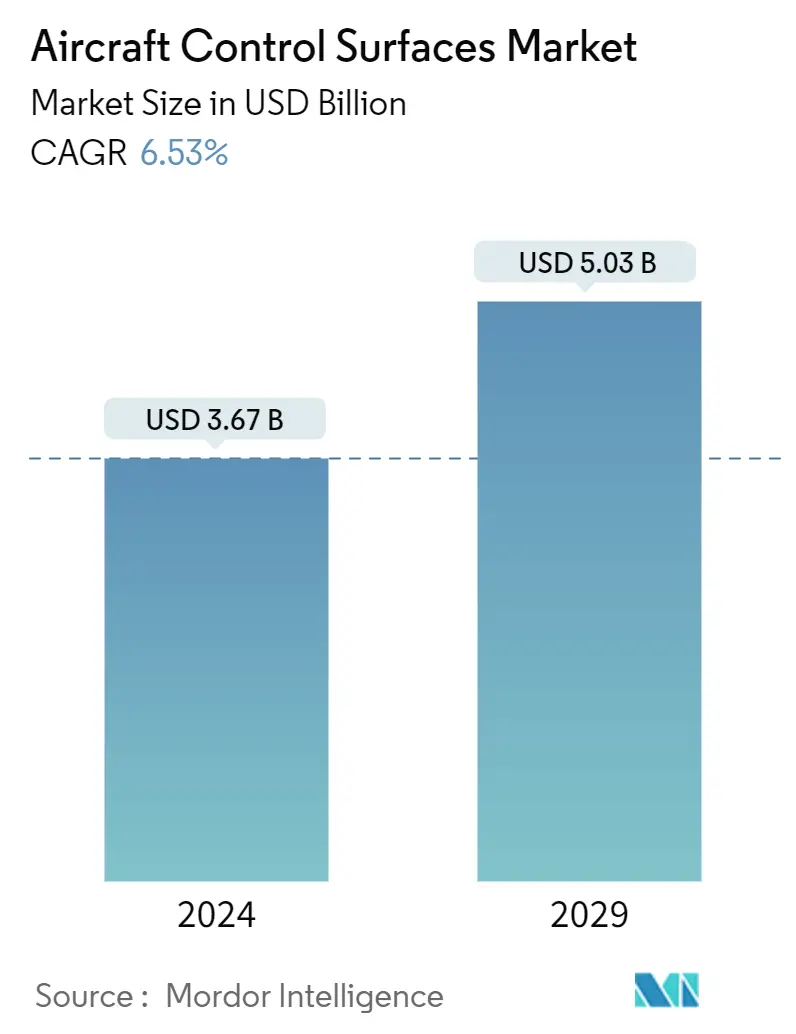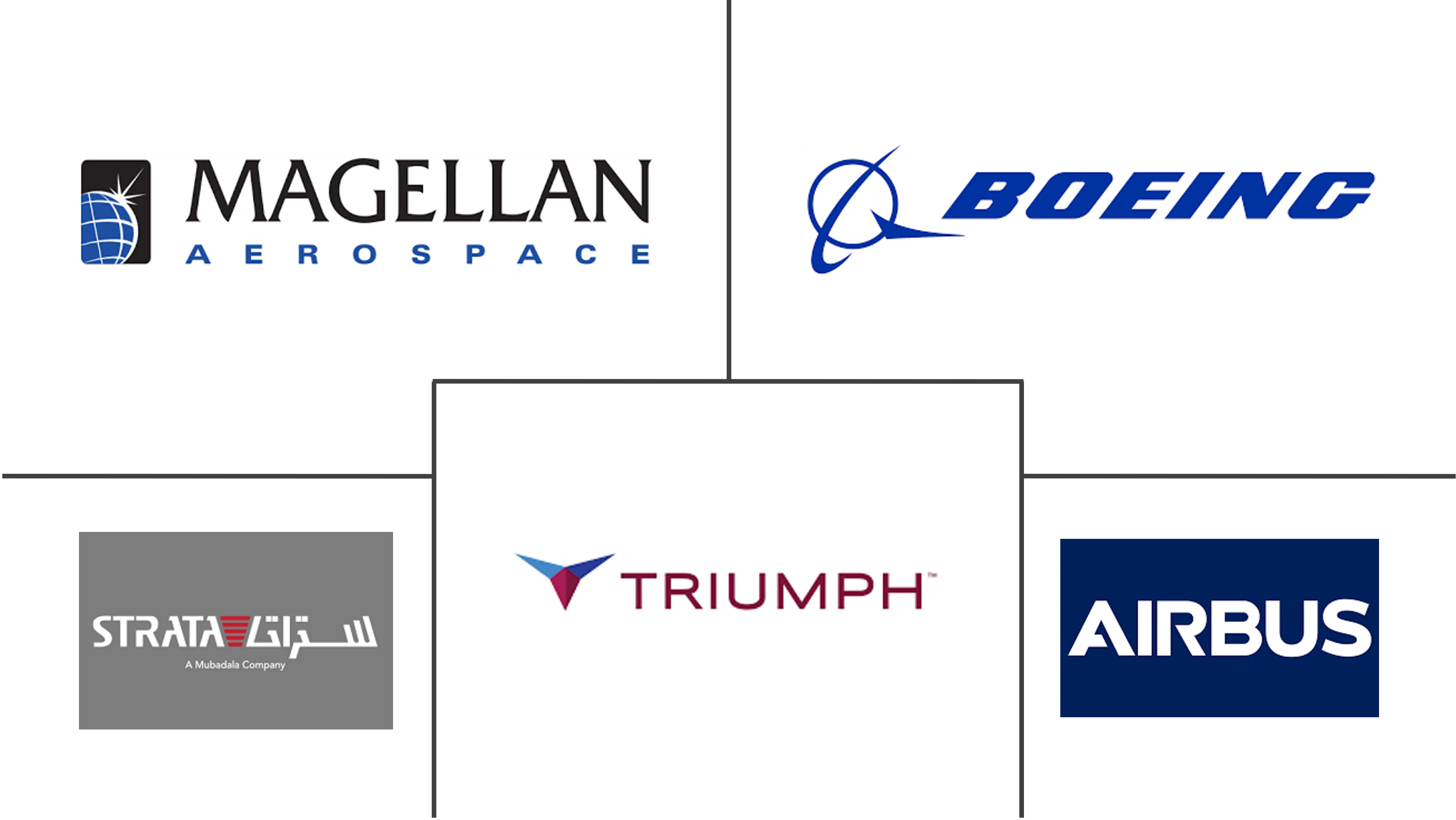Market Size of Aircraft Control Surfaces Industry

| Study Period | 2019 - 2029 |
| Market Size (2024) | USD 3.67 Billion |
| Market Size (2029) | USD 5.03 Billion |
| CAGR (2024 - 2029) | 6.53 % |
| Fastest Growing Market | Asia Pacific |
| Largest Market | North America |
Major Players
*Disclaimer: Major Players sorted in no particular order |
Aircraft Control Surfaces Market Analysis
The Aircraft Control Surfaces Market size is estimated at USD 3.67 billion in 2024, and is expected to reach USD 5.03 billion by 2029, growing at a CAGR of 6.53% during the forecast period (2024-2029).
Growing orders for new aircraft are the primary growth driver for the market. The procurements of new aircraft may generate demand for aircraft parts and components, like the control surfaces, during the forecast period.
Innovations in aircraft designs gave rise to technologies like dual-purpose flight control surfaces. The growing research in non-conventional aircraft designs is expected to generate new opportunities for the market in the coming years.
The high price of advanced aircraft management systems is a market restraint for low-budget air carriers on the global market. Consistent adherence between public authorities and aviation agencies to installing adequate safety and control systems is expected to contribute significantly to the growth in the global aircraft control surfaces market over the forecast period.
Aircraft Control Surfaces Industry Segmentation
An aircraft surface control is an aerodynamic device that allows the pilot to adjust and control the aircraft's flight attitude. Surface control surfaces are classified into two types: primary surface and secondary surface. The primary control surfaces of an airplane include the ailerons, rudder, and elevator. Secondary control surfaces shall include tabs, flaps, spoilers, and slats.
The aircraft control surfaces market is segmented by type, end-user, and geography. The market is segmented by type into primary flight control surfaces (ailerons, elevators, and rudders) and secondary flight control surfaces (flaps, spoilers, slats, and other secondary flight control surfaces). By end-user, the market is segmented into commercial aircraft, military aircraft, and general aviation aircraft. The report also covers the market sizes and forecasts for the aircraft control surfaces market in major countries across different regions. For each segment, the market size is provided in terms of value (USD).
| Type | ||||||
| ||||||
|
| End-User | |
| Commercial Aircraft | |
| Military Aircraft | |
| General Aviation Aircraft |
| Geography | ||||||||
| ||||||||
| ||||||||
| ||||||||
| ||||||||
|
Aircraft Control Surfaces Market Size Summary
The aircraft control surfaces market is poised for significant growth over the forecast period, driven primarily by increasing orders for new aircraft. This demand is expected to spur the need for various aircraft components, including control surfaces. Innovations in aircraft design, such as dual-purpose flight control surfaces, are creating new opportunities within the market. However, the high cost of advanced aircraft management systems poses a challenge for budget-conscious air carriers. The commercial aircraft segment holds a dominant market share due to the higher number of commercial aircraft deliveries compared to military aircraft. The market is also experiencing a surge in demand for general aviation aircraft, particularly in regions like Asia-Pacific, where countries such as China and India are leading the growth trajectory.
The market landscape is semi-consolidated, with key players like Triumph Group, Inc., Magellan Aerospace Corporation, Strata Manufacturing PJSC, The Boeing Company, and Airbus SE maintaining long-term relationships with aircraft OEMs. These companies are focusing on innovations that enhance control surface technologies, aiming to reduce weight, drag, and fuel consumption. Initiatives such as Boeing's focused factory aim to lower manufacturing costs and improve quality and delivery efficiencies. Recent agreements and contracts, such as those involving Joby Aviation, Inc. and GKN Aerospace, highlight the industry's shift towards advanced materials and manufacturing processes. The development of new aircraft models and the adoption of cutting-edge technologies are expected to further propel market growth in the coming years.
Aircraft Control Surfaces Market Size - Table of Contents
-
1. MARKET DYNAMICS
-
1.1 Market Overview
-
1.2 Market Drivers
-
1.3 Market Restraints
-
1.4 Industry Attractiveness - Porter's Five Forces Analysis
-
1.4.1 Bargaining Power of Suppliers
-
1.4.2 Bargaining Power of Buyers/Consumers
-
1.4.3 Threat of New Entrants
-
1.4.4 Threat of Substitute Products
-
1.4.5 Intensity of Competitive Rivalry
-
-
-
2. MARKET SEGMENTATION
-
2.1 Type
-
2.1.1 Primary Flight Control Surfaces
-
2.1.1.1 Ailerons
-
2.1.1.2 Elevators
-
2.1.1.3 Rudders
-
-
2.1.2 Secondary Flight Control Surface
-
2.1.2.1 Flaps
-
2.1.2.2 Spoilers
-
2.1.2.3 Slats
-
2.1.2.4 Other Secondary Flight Control Surfaces
-
-
-
2.2 End-User
-
2.2.1 Commercial Aircraft
-
2.2.2 Military Aircraft
-
2.2.3 General Aviation Aircraft
-
-
2.3 Geography
-
2.3.1 North America
-
2.3.1.1 United States
-
2.3.1.2 Canada
-
-
2.3.2 Europe
-
2.3.2.1 Germany
-
2.3.2.2 United Kingdom
-
2.3.2.3 France
-
2.3.2.4 Italy
-
2.3.2.5 Russia
-
2.3.2.6 Rest of Europe
-
-
2.3.3 Asia-Pacific
-
2.3.3.1 China
-
2.3.3.2 Japan
-
2.3.3.3 India
-
2.3.3.4 South Korea
-
2.3.3.5 Australia
-
2.3.3.6 Rest of Asia-Pacific
-
-
2.3.4 Latin America
-
2.3.4.1 Brazil
-
2.3.4.2 Mexico
-
2.3.4.3 Rest of Latin America
-
-
2.3.5 Middle-East and Africa
-
2.3.5.1 United Arab Emirates
-
2.3.5.2 Saudi Arabia
-
2.3.5.3 Egypt
-
2.3.5.4 South Africa
-
2.3.5.5 Rest of Middle-East and Africa
-
-
-
Aircraft Control Surfaces Market Size FAQs
How big is the Aircraft Control Surfaces Market?
The Aircraft Control Surfaces Market size is expected to reach USD 3.67 billion in 2024 and grow at a CAGR of 6.53% to reach USD 5.03 billion by 2029.
What is the current Aircraft Control Surfaces Market size?
In 2024, the Aircraft Control Surfaces Market size is expected to reach USD 3.67 billion.

